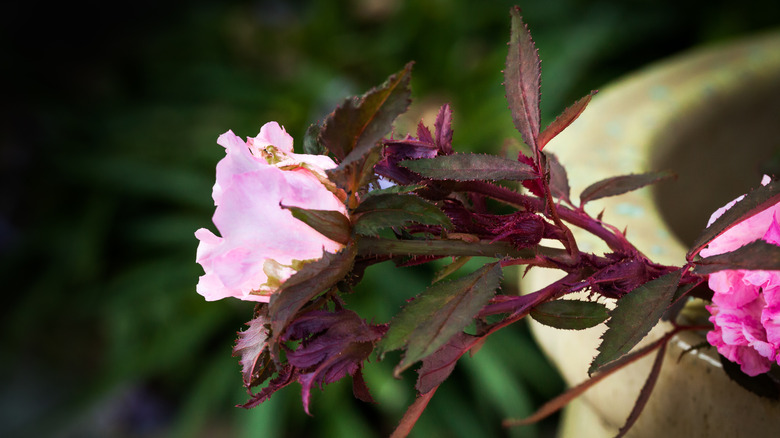The Lethal Disease That Could Be Lurking In Your Rose Garden
If you care for roses in your garden, you may be familiar with the different types of infections that can plague your blossoms. One in particular, rose rosette disease (RRD), is caused by the rose rosette virus, which can affect ornamental roses. This virus is transmitted by mites that feed on plant tissues — rose bushes. An infected bush will often experience abnormal growth, distorted foliage, and an overall decline in health.
One of the most identifying symptoms is the development of small red or yellow growths that spread along the stems of the bush. They're sometimes called "witches' brooms" as they feature clusters of short, distorted shoots that reach out to a single point and resemble the tool. Additionally, the rose bush may also experience succulent stems, distorted leaves and discolored, irregular blooms. Eventually, the foliage may also become thorny and brittle.
Unfortunately, RRD does not typically end well for rose bushes. Aside from having an unsightly appearance, the virus will ultimately weaken the plant's health, making it more susceptible to other diseases and pests. In severe cases, it may even kill the bush. Not to mention, the infection of one plant can easily spread to another if it isn't treated. Fortunately, there are steps you can take to help prevent RRD from destroying the precious blooms on your property.
How to prevent rose rosette disease
If your roses are a priority in your garden, be on the lookout for rose rosette disease so that you can protect your precious plants. One of the best ways to prevent RRD is to select disease-resistant rose bush varieties when planting your garden. At the same time, buy your roses from a trusted nursery and inspect them deeply for any symptoms before introducing them to your property. Taking these two precautions can greatly reduce the likelihood of introducing RRD to your plants.
Another good practice to protect your roses is to disinfect pruning tools in between uses. Using the same garden shears around your garden can easily spread diseases among your plants. Moreover, when pruning, be sure to discard all infected or dead plant materials as they may harbor the mites or infected foliage. Do not add diseased plant materials to your compost pile. Instead, dispose of them in a closed yard waste bag.
Finally, you can prevent RRD by regularly monitoring your roses for eriophyid mites and killing them. Purchase a miticide specifically tailored to these types of pests and use it according to the package instructions to help prevent infection. Moreover, these types of mites thrive around weeds, so you may also want to use an herbicide or manually remove nearby weeds to deter these pests.
How to treat RRD
Should you discover that your roses have symptoms of rose rosette disease, you will have to come to terms with the fact that there is no cure. As soon as you observe any symptoms, remove the rose bush — or at least consult with a horticulturist to confirm the presence of RRD. It may be tempting to prune the affected parts, which may delay the progression of the disease and improve your plant's appearance. But it could also allow the mites to spread to any neighboring roses. To get rid of them, cover the entire rose bush with a large trash bag and trap the mites before cutting the stems at the root ball. Seal the bag and dispose of it to protect the rest of your garden.
In addition to prolonging the life of infected plants, consider how to protect any uninfected roses. Use your herbicide on any nearby roses that do not display signs of infection to kill any mites that may have migrated over. You could also turn to horticultural oils or insecticidal soaps. Just be sure to read the labels carefully — some of them can impact beneficial insects like pollinators that are necessary for your uninfected blooms. Continue caring for your healthy roses to protect them from infection by ensuring their sunlight, water, and nutrients are all adequate.


